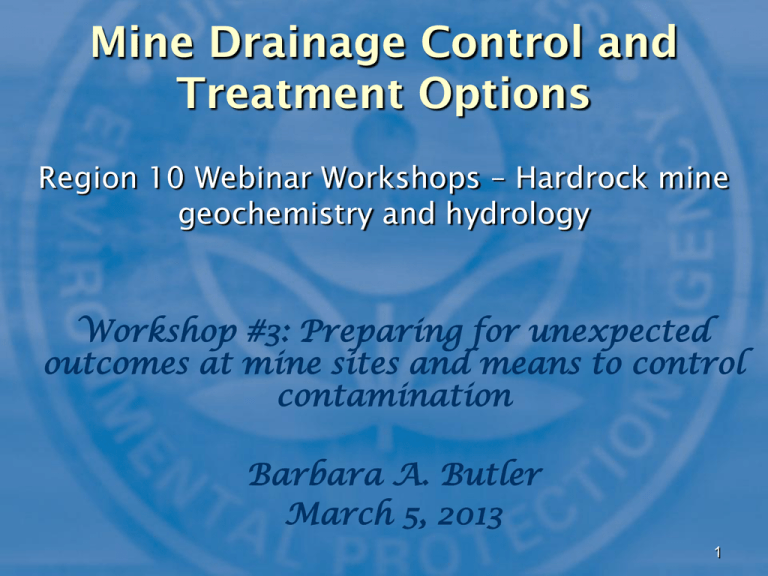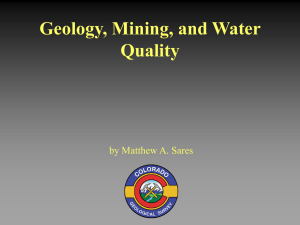Remedial options - CLU-IN
advertisement

Mine Drainage Control and Treatment Options Region 10 Webinar Workshops – Hardrock mine geochemistry and hydrology Workshop #3: Preparing for unexpected outcomes at mine sites and means to control contamination Barbara A. Butler March 5, 2013 1 Disclaimer Mention of trade names or products does not constitute the U.S. EPA’s endorsement. The information presented is the sole responsibility of the author and does not necessarily represent the views of the U.S. EPA 2 Overview Definitions How does mine-drainage form? Mitigation measures What happens when drainage enters a stream? Design and operation Precipitation and sorption reactions Remedial options Active treatment Passive (semi-passive) treatment 3 Definitions Mitigation All steps taken to prevent (avoid), reduce (minimize), treat, and compensate for any potential adverse impacts (risk) on the environment from a given activity (hazard) Proper planning, design, construction, operation, management, and closure of waste and water containment and treatment facilities, monitoring and maintenance over all mine-life phases, including after mine closure. 4 Definitions Reclamation Refers to restoring1 a disturbed area to an acceptable form and planned use, following active mining Includes actions taken to mitigate against future risks 1Rarely is a site able to be restored to what it was prior to mining, which is the strictest definition of restoration. 5 Definitions Remediation Refers to correcting an issue that has become evident, such as cleaning up a spill or an abandoned mine site 6 Definitions Best Management Practice (BMP) With respect to the CWA, this term generally applies to specific measures for managing non-point source runoff from storm water (40 CFR Part 130.2(m)). 7 Overview Definitions How does mine-drainage form? Mitigation measures What happens when drainage enters a stream? Design and operation Precipitation and sorption reactions Remedial options Active treatment Passive (semi-passive) treatment 8 How Does Mine-Drainage Form? Mining Process Exposes pyrite and other minerals to the atmosphere Grinding processes Larger surface areas for exposure (weather more quickly) Pyrite http://en.wikipedia.org/wiki/File:Pyrite_3.jpg 9 How Does Mine-Drainage Form? Initiator Reaction 2 2 22 2 4 FeS 3 . 5 O H O Fe 2 SO 2 H Pyrite Propagation Cycle Bact 2 3 Fe 0 . 25 O H 0 . 5 H O F 2106 x faster 2 3 2 2 14 Fe FeS 8 H O 15 Fe 2 SO 1 H 2 2 4 Pyrite http://en.wikipedia.org/wiki/File:Pyrite_3.jpg 10 How Does Mine-Drainage Form? Acidic, neutral or alkaline1? Acid-producing reactions Pyritic minerals; oxyhydroxide formation Acid-consuming reactions Carbonate minerals (produce alkalinity) Aluminosilicate (clay minerals) E.g., limestone and dolomite E.g., muscovite, kaolinite Formation from non-pyritic minerals 1Mining-influenced waters (MIW) coined by Dr. Ron Schmiermund in 1997 to encompass all types 11 Overview Definitions How does mine-drainage form? Mitigation measures What happens when drainage enters a stream? Design and operation Precipitation and sorption reactions Remedial options Active treatment Passive (semi-passive) treatment 12 Mitigation Measures Waste rock piles Tailings storage facilities Measures presented are not inclusive of all options available. 13 Mitigation Measures Waste Rock Piles Minimize leaching of acidity and ions Minimize exposure of water bodies to seepage/drainage Minimize acid generation 14 Mitigation Measures Waste Rock Piles Minimize leaching of acidity and ions Encapsulation with impermeable layer Compaction Minimize infiltration, seepage, and oxygen transfer Minimizes voids Progressive reclamation 15 Mitigation Measures Waste Rock Piles Minimize exposure of water bodies to seepage/drainage Locating piles within cone of depression Drainage flows to pit and is pumped out with groundwater (GW) Under-drains, diversions, GW monitoring wells, liners (clay and/or geosynthetic), 16 Mitigation Measures Waste Rock Piles Minimize acid generation Segregation of potentially acid-generating (PAG) rock with non-acid-generating (NAG) rock Mining of sub-economic ore (PAG) as blending material, or at end of operations Layering of PAG rock NAG rock Blending with acid-consuming materials Bactericide Isolation (encapsulation) 17 Mitigation Measures Tailings Storage Facilities Wet storage Most common Mining uses a lot of water and facility provides dual purpose as storage Seismic and flood considerations Dry storage Filtered tailings removes maximum amount of water Not appropriate for PAG 18 Mitigation Measures Tailings Storage Facilities Isolation of PAG material Selective processing methods Sub-aqueous disposal to minimize oxidation Encapsulation 19 Mitigation Measures Tailings Storage Facilities Minimize exposure of water bodies to seepage/drainage Liners, under-drains, decant systems Diversions for clean water Seepage collection systems Monitoring wells downstream Caps on beaches, drawdown water, erosion control – closure 20 Overview Definitions How does mine-drainage form? Mitigation measures What happens when drainage enters a stream? Design and operation Precipitation and sorption reactions Remedial options Active treatment Passive (semi-passive) treatment 21 What happens when the drainage enters a stream? W a te rC o lu m n F lo w P re c ip ita tio n/S o rp tio n Diss D is s o lu tio n/D e -s o rp tio n M E x c h a n g e M Diss S e d im e n t M Part . S c o u rin g S e ttlin g M Part . ‘M’ = metal; ‘Diss’ = dissolved; ‘Part’ = particulate 22 What happens when the drainage enters a stream? W a te rC o lu m n F lo w P re c ip ita tio n/S o rp tio n Diss D is s o lu tio n/D e -s o rp tio n M E x c h a n g e M Diss S e d im e n t M Part . S c o u rin g S e ttlin g M Part . ‘M’ = metal; ‘Diss’ = dissolved; ‘Part’ = particulate 23 What happens when the drainage enters a stream? Iron (HFO) Rapid formation in water column at pH > ~ 3.5 Oxidation of ferrous iron precedes precipitation 24 What happens when the drainage enters a stream? Aluminum (ALO) Rapid formation in water column at pH > ~ 5 No oxidation necessary 25 What happens when the drainage enters a stream? Manganese (HMO) Requires oxidation Requires a surface Formation at pH > ~ 9 26 What happens when the drainage enters a stream? Manganese (HMO) Formation may be facilitated by periphyton 27 What happens when the drainage enters a stream? Manganese (HMO) Formation may be facilitated by periphyton Algal photosynthesis 6 HCO 6 H O C H O 6 O 6 O h 3 2 6 1 6 2 2 h p ig hh 2 2 2 Mn O Mn ( s ) 28 Overview Definitions How does mine-drainage form? Mitigation measures What happens when drainage enters a stream? Design and operation Precipitation and sorption reactions Remedial options Active treatment Passive (semi-passive) treatment 29 Remedial Options Isolation, removal, treatment of source Physical removal Grouting reactive rock surfaces Redirection of water flow Adding neutralizing agents 30 Remedial Options Water treatment Removal of acidity Removal of metals Removal of salts (Na, Mg, Ca, K) Removal of sulfate Ultimately – removal of toxicity 31 Remedial Options Water Treatment Active Passive 32 Remedial Options Water Treatment Active Ongoing humanly operated Frequent maintenance and monitoring Generally requires external energy source Generally type chosen for active mining 33 Remedial Options Water Treatment Passive (semi-passive) Constant human intervention not required Natural processes Natural materials Regeneration of materials Gravity feed versus pumping 34 Remedial Options Active Treatment Chemical Reaction Oxidation Aeration to increase oxygen content or use of oxidizers Neutralization, precipitation, and sorption Hydroxide, Ca(OH)2, CaO, NaOH; MgO, Carbonate, CaCO3, Na2CO3 Fly ash; slag; kiln dust Coagulation, flocculation 35 Remedial Options Active Treatment Physical Membrane Reverse osmosis Micro, ultra, or nano-filtration Ion exchange 36 Remedial Options Passive/Semi-passive Treatment Oxidation Aeration Neutralization and precipitation Ion exchange Sorption (organic and inorganic) Plant uptake 37 Remedial Options Passive/Semi-passive Treatment Aerobic wetland Anoxic limestone drain (ALD) Anaerobic wetland Sulfate-reducing bioreactor (SRBR) Biochemical reactor (BCR) Permeable reactive barrier (PRB) 38 Remedial Options Passive/Semi-passive Treatment Aerobic wetland Best for net alkaline drainage Precipitation and sorption Shallow – aeration Plants – uptake 39 Remedial Options Passive/Semi-passive Treatment Anoxic limestone drain (ALD) Best for net acidic, low Fe3+, low Al3+, and low dissolved oxygen Neutralize acidity Effluent to aerobic pond 40 Remedial Options Passive/Semi-passive Treatment Reducing alkalinity producing system (RAPS) Similar to ALD, but reduces the water then adds alkalinity 41 Remedial Options Passive/Semi-passive Treatment Anaerobic wetland (BCR) Best for net acidic, low Fe3+, low Al3+, high metals Reduction of redox active elements Microbial reduction of sulfate to sulfide Metal sulfide precipitation Sorption of metals Organic / inorganic 42 Remedial Options Passive/Semi-passive Treatment Anaerobic wetland (BCR) Natural materials Hay, straw, wood chips, manure, crushed limestone Layer of water Generally vertical flow Effluent to aerobic pond or weir 43 Remedial Options Passive/Semi-passive Treatment Permeable Reactive Barrier (PRB) Similar to BCR, but treat groundwater 44 Remedial Options What to Choose? Choice depends on Amounts - money, time, land, metals, acid, flow Site access Active or abandoned mine Specific contaminants 45 Passive Treatment Case Study (Standard Mine, Colorado) Operation began in the 1930’s Devoid of aquatic life Ag, Au, Pb, Zn Abandoned in 1966 Adit drains into Elk Creek Cd, Cu, Fe, Pb, Mn, and Zn exceed WQS Elk Creek feeds into Coal Creek Source of DW for Crested Butte 46 Standard Mine Crested Butte – remote location Constructed in 2007 11,000 ft 1.2 gpm Cd, Cu, Fe, Pb, Mn, Zn No electricity Photo by Scott Jacobs - NRMRL 47 Aerobic Polishing Cell(s) [2008] Remove biological oxygen demand Increase dissolved oxygen Degas sulfide and ammonia Reduce total suspended solids Oxidize and precipitate any Fe 48 Passive Treatment Case Study (Standard Mine, Colorado) Year-round treatment Automated sampling pH, temperature, ORP Satellite reporting Protection from weather 49 33-58 feet annual snowfall http://dept.ca.uky.edu/asmr/W/Full%20Papers%202008/0892-Reisman-OH.pdf 50 Passive Treatment Case Study (Standard Mine, Colorado) Methods Whole effluent toxicity tests (WET) Ceriodaphnia dubia (water flea) Pimephales promelas (fathead minnow) Acute 48-hr LC50 Percentage of water Control survival > 90% 51 Passive Treatment Case Study (Standard Mine, Colorado) % Removal Analyte Site BCR APC Al N/A N/A As N/A N/A Cd 100 +/- 2 100 +/- 2 Cu 94 +/- 9 94 +/- 9 Fe -266 +/- 518 100 +/- 10 Ni N/A N/A Pb 94 +/- 16 91 +/- 17 Zn 100 +/- 3 100 +/-3 SO4 39 +/- 4 72+/- 5 52 Standard Mine Acute Toxicity # LC50 (%, v/v) 100 † † † † 80 60 40 Gray = water flea Black = fathead minnow 20 1% 2% 0 -A INF -B INF BC F F R-E A -A -B -B F F F F F F -E -E -E R C C P P C A A B Sample ID 53 Standard Mine Acute Toxicity # LC50 (%, v/v) 100 † † † † 35% mortality 80 60 40 Gray = water flea Black = fathead minnow 20 0 -A INF -B INF BC F F R-E A -A -B -B F F F F F F -E -E -E R C C P P C A A B Sample ID 54 Standard Mine Acute Toxicity # LC50 (%, v/v) 100 † † † † 80 60 40 Not different from control Gray = water flea Black = fathead minnow 20 0 -A INF -B INF BC F F R-E A -A -B -B F F F F F F -E -E -E R C C P P C A A B Sample ID 55 Standard Mine Acute Toxicity # LC50 (%, v/v) 100 † † † † Effluent samples more toxic to fathead minnow than to the water flea 80 60 40 20 0 -A INF -B INF BC F F R-E A -A -B -B F F F F F F -E -E -E R C C P P C A A B Sample ID 56 Effect of Aeration 100% Percent Survival (100% sample) 100 80 60 40 <20% 20 0 SM-A SM-B SM-A aerated SM-B aerated Sample ID 57 Dissolved Gaseous Species Standard Mine 2.5 2 ug/l H2S .2 to 5 mg/l NH3 1.5 0.04 0.03 H2S (aq) NH3 (aq) (10C) 1 0.02 NH3 (aq) (20C) 0.5 Ammonia (mg/l) Sulfide (mg/l) 2 0.05 0.01 0 0 2 4 6 8 10 12 pH 58 Passive Treatment Case Study (Standard Mine, Colorado) Concluding remarks Results strongly suggest toxicity from dissolved hydrogen sulfide gas Other BCRs may have different toxicants, depending on: Contaminants present and efficiency of removal Concentrations of dissolved gases pH of effluent 59 Thank you! Study at Standard Mine and 3 other sites: Butler, BA, Smith, ME, Reisman, DJ, Lazorchak, JM. 2011. Metal removal efficiency and ecotoxicological assessment of field-scale passive treatment biochemical reactors. Environmental Toxicology & Chemistry. 30(2):385-392. 60





